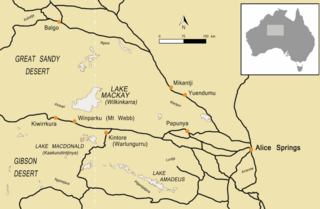| Pintupi | |
|---|---|
| Native to | Australia |
| Region | Western Australia, Northern Territory; Papunya settlement, Yuendumu and Kintore, Balgo hills |
| Ethnicity | Pintupi =? Ildawongga, ?Wenamba |
Native speakers | 271 (2021 census)[1] |
Pama–Nyungan
| |
| Dialects | |
| Language codes | |
| ISO 639-3 | piu |
| Glottolog | pint1250 |
| AIATSIS[2] | C10 Pintupi |
| ELP | Pintupi-Luritja |
 | |
 Pintupi is classified as Vulnerable by the UNESCO Atlas of the World's Languages in Danger | |
Pintupi (/ˈpɪntəpi, ˈpɪnə-, -bi/)[3] is an Australian Aboriginal language. It is one of the Wati languages of the large Pama–Nyungan family. It is one of the varieties of the Western Desert Language (WDL).
Pintupi is a variety of the Western Desert Language spoken by indigenous people whose traditional lands are in the area between Lake Macdonald and Lake Mackay, stretching from Mount Liebig in the Northern Territory to Jupiter Well (west of Pollock Hills) in Western Australia. These people moved (or were forced to move) into the indigenous communities of Papunya and Haasts Bluff in the west of the Northern Territory in the 1940s–1980s. The last Pintupi people to leave their traditional lifestyle in the desert came into Kiwirrkura in 1984.[4] Over recent decades they have moved back into their traditional country, setting up the communities of Kintore (in Pintupi known as Walungurru) in the Northern Territory, Kiwirrkura and Jupiter Well (in Pintupi Puntutjarrpa) in Western Australia.
Children who were born in Papunya and Haasts Bluff grew up speaking a new variety of Pintupi, now known as Pintupi-Luritja, due to their close contact with speakers of Arrernte, Warlpiri and other varieties of the WDL. This has continued through the moves west so that most Pintupi people today speak Pintupi-Luritja, although there remains a clear distinction between the more western and eastern varieties.[citation needed]
Pintupi is one of the healthier Aboriginal languages and is taught to local children in schools.[citation needed]
- ^ "SBS Australian Census Explorer". Retrieved 10 January 2023.
- ^ C10 Pintupi at the Australian Indigenous Languages Database, Australian Institute of Aboriginal and Torres Strait Islander Studies
- ^ "Pintupi". Oxford English Dictionary (Online ed.). Oxford University Press. (Subscription or participating institution membership required.)
- ^ Myers, Fred (1988). "Locating Ethnographic Practice: Romance, Reality and Politics in the Outback". American Ethnologist. 15 (4): 609–624. doi:10.1525/ae.1988.15.4.02a00010.